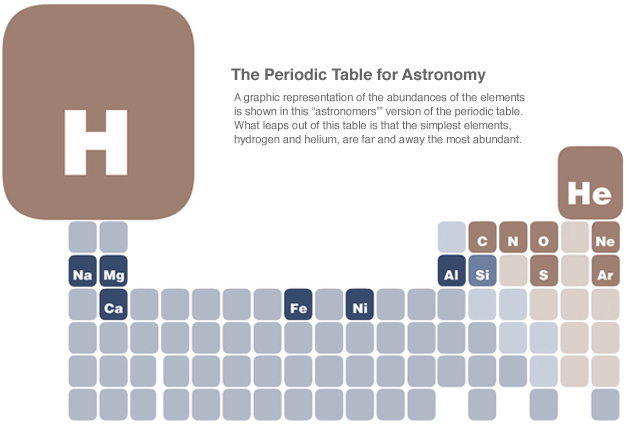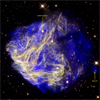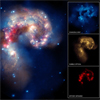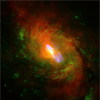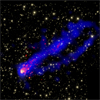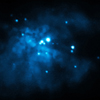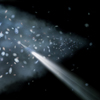Disclaimer: This material is being kept online for historical purposes. Though accurate at the time of publication, it is no longer being updated. The page may contain broken links or outdated information, and parts may not function in current web browsers. Visit chandra.si.edu for current information.
Chandra, Cosmos and Chemistry
by Wallace TuckerOctober 05, 2010 ::
The year 2011 has been proclaimed (by the United Nations and a host of other proclaimers) to be the International Year of Chemistry, a worldwide celebration of the achievements of chemistry and its contributions to the well-being of humankind.
Chemistry, the study of the intricate dances and bondings of low-energy electrons to form the molecules of the various elements that make up the world we live in, may seem far removed from the thermonuclear heat in the interiors of stars and the awesome power of supernovas. Yet, there is a fundamental connection between them.
The formation of the elements began about 14 billion years ago, in the early minutes of the Big Bang. After about 20 minutes, the ordinary matter in the Universe was a mixture of 75% protons or hydrogen nuclei, 25% helium nuclei, and free-ranging electrons, which would start to be bound into atoms a few hundred thousand years later. In essence, the history of the formation of the elements can be divided into two main phases: one that ended after the first 20 minutes, and the other that has been ongoing since the formation of the first stars 13+ billion years ago.
After that initial one third of an hour, the expanding Universe cooled below the point where nuclear fusion could operate. This meant that no evolution of matter could occur again until stars were formed a few million years later, when the buildup of elements heavier than helium could begin.
Stars evolve through a sequence of stages in which nuclear fusion reactions in their central regions build up helium and other elements The energy supplied by fusion reactions creates the pressure needed to hold the star up against gravity. Winds of gas escaping from stars distribute some of this processed matter into space in a relatively gentle manner and supernovas do it violently.
Chandra images and spectra of individual supernova remnants reveal clouds of gas rich in elements such as oxygen, silicon, sulfur, calcium and iron, and track the speed at which these elements have been ejected in the explosion. The Chandra image of the Cas-A SNR shows iron rich ejecta outside silicon-rich ejecta, thus indicating that turbulent mixing and an aspherical explosion turned much of the original star inside out. Observations of Doppler-shifted emission lines for Cas A and other supernova remnants are providing three-dimensional information on the distribution and velocity of the supernova ejecta which will help to constrain models for the explosion. In a similar vein observations of the N49 supernova remnant reveal a bullet-shaped cloud of gas rich in neon, silicon and sulfur that have been ejected into the surrounding gas at a speed of five million miles per hour.
On a larger scale, observations of galaxies undergoing bursts of star formation show that vast regions of these galaxies have been enriched by the combined action of thousands of supernovas. The Antennae galaxy system was produced by the collision of two galaxies. This collision created bursts of star formation and, few million years later, thousands of supernovas which heated and enriched clouds of gas thousands of light years in extent.
An unexpected agent for distributing heavy elements throughout a galaxy is a supermassive black hole in the center of a galaxy. Gas spiraling toward black holes can that become overheated and produce a wind of gas that flows away from the black hole, or it can create an intense electromagnetic field that drives enriched material into the outer reaches of the galaxy and beyond.
Enriched gas can also be stripped from a galaxy, if the galaxy falls into a galaxy cluster. The pressure of the hot diffuse gas that pervades a galaxy cluster blows the gas out of the galaxy into the intergalactic medium, thereby enriching it.
On a still larger scale, oxygen has been detected in intergalactic filaments millions of light years in length. This oxygen was likely produced more than ten billion years ago, in some of the first supernovas to occur in the history of the Universe. If the rate of supernovas gets so high that the combined effects of many supernova shock waves drives a galactic-scale wind that blows the gas out of the galaxy. A prime example is the galaxy M82.
Galactic winds such as the one in M82 are rare today, but they were common billions of years ago when galaxies were very young and stars were forming rapidly because of frequent collisions between galaxies. Chandra showed that the Sculptor Wall, a collection of gas and galaxies that stretches across tens of millions of light years, contains a vast reservoir of gas enriched in oxygen from galactic winds. The Sculptor Wall is thought to be part of an enormous web of hot, diffuse gas containing as much as half of all the ordinary matter in the Universe.
As the enrichment of the interstellar and intergalactic gas has proceeded over vast stretches of space and time, the chemistry of the cosmos has become richer, too. Subsequent generations of stars have formed from interstellar gas enriched in heavy elements. Our Sun, Solar System, and indeed the existence of life on Earth are direct results of this long chain of stellar birth, death, and rebirth. In this way, the evolution of matter, stars and galaxies are all inextricably tied together and so too are astronomy and chemistry.
Disclaimer: This material is being kept online for historical purposes. Though accurate at the time of publication, it is no longer being updated. The page may contain broken links or outdated information, and parts may not function in current web browsers. Visit chandra.si.edu for current information.

